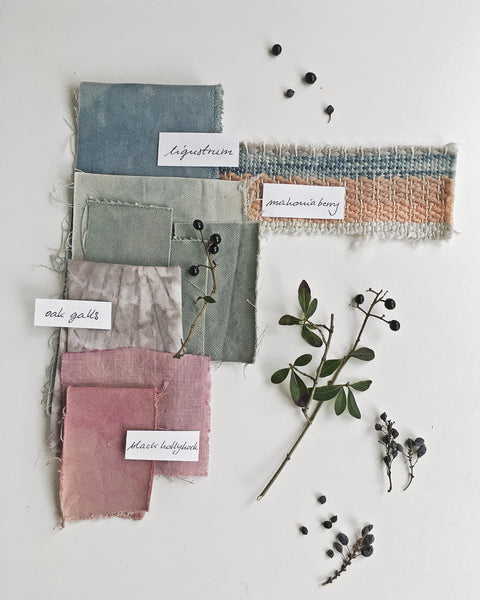MY LOCAL DYE PLANTS TO COLOR FABRIC AND YARN

Have you ever tried extracting colors from plants? There are hundreds of plants bearing beautiful dyes, growing all around us. Yes, some plants are traditionally recognized as basic dye sources, but if you open your eyes and look around, you will find an abundance of color in front of your door. I made a list of plants local to me, but I strongly encourage you to try plants that grow around where you live. And living in a city is no excuse here! I live in a big city myself - but even in Berlin, Germany I found enough plants to make a full spectrum of color.
My reversed approach
I started my adventure with plant dyeing somewhat counterintuitive, with practice rather than theory. Instead of diving into books and resources, I started with experimenting. Walking my sweet dog in a local park every morning, I had a lot of time to collect plants. The possibilities are truly endless: young leaves and first flowers popping in spring, weeds and trees giving their full potential throughout the summer, colorful berries decorating the bushes in autumn and broken branches, fallen acorns, and cones to be found before the first snow. No matter the season, nature always has something in stock for us.
Extracting the dye
When we would come back home, I would slowly start extracting the colors and testing the dyes on fabric. I tried to test a different plant every other day. Some of them were elusive and got spoilt when too much heat was applied for too long, some needed days and multiple heating sessions to start showing their true potential. Trial and error are the best teachers here. This post is not a how-to about achieving specific colors anyway - it’s an inspiration for your quest of finding dyes local to you and getting in touch with your surroundings.
How to store your plants
There is no one-solution-fits-all and again, you will need to experiment a bit. I can give you a few general tips though. Most of the plants keep their dye potential when dried. Put them on your windowsill or hang up and after they dry, store in paper bags or boxes. This way the plant material will be able to breathe and won’t develop mold. There are plants, though, that work best when used fresh, like goldenrod. Dried goldenrod produces a much paler color. My solution is to put it in my freezer. I used some frozen goldenrod 10 months later and it dyed beautifully. Another good dye plant to freeze is are ligustrum berries, the reason here is more interesting, though. Ligustrum berries seem to give a better color after the first frost, so either collect and use after the first cold days or just put it in your freezer before using (be careful, these berries are toxic and the fumes shouldn’t be inhaled!).
Collect with respect
When collecting dye material, please do so with respect. Take only as much as you need, and leave enough for the plants to survive and the animals to feed. In winter, birds eat berries, so don’t take away the food they really need! When picking the leaves, collect from many different bushes or trees, not too stress the plant. In essence - please, be respectful.
What about colorfastness?
Before we dive right in, here’s a disclaimer: some of these dyes are not very lightfast (fugitive dyes) and will fade no matter how you fix them. Mordants don’t help in this case! I still add these plants to the list, as they can be useful for hobby dyers who want to redye colors every season or for people working on craft projects with kids. Another important note: please make sure you know what you’re collecting and avoid using big quantities of plants that are toxic.
If you need help mordanting (fixing the color), check out my easy to follow mordanting flow chart.
And if you’d like to join one of my workshops and test some of these plants, here’s a link to my events.
Local dye plants growing wild
YELLOW
-
chamomile - pale yellow
-
birch leaves - pale yellow
-
goldenrod - sunny yellow
-
purple budleja - sunny yellow
-
marigolds - sunny yellow

GREEN
-
marigolds - olive green with iron
-
birch leaves - olive green with iron
-
nettles - pale green, pale grey with iron
-
ferns - light green to red-pink

ORANGE AND PINK
-
rhododendron leaves - pale orange (toxic)
-
willow leaves - orange-red
-
firethorn berries - orange-red
-
bracken fern
-
hibiscus flowers - orange-red to light blue-green

PURPLE AND BLUE
-
mahonia berries - purple
-
elderberries - pale purple
-
oak galls - grey-purple with iron
-
ligustrum berries - blue (toxic)
-
black hollyhock - blue to grey

BROWN AND GREY
-
oak leaves - beige, grey with iron
-
acorns - brown-beige, grey with iron
-
alder cones - brown-beige, grey with iron
-
walnut leaves - deep brown
-
walnut skins - deep brown

Find some more dyestuff in your kitchen
If that’s not enough for you (or it’s winter and you just can’t wait - I get it!), try testing some of your kitchen waste. Remember that most of these colors are not lightfast, but they make a nice weekend project if you want to have fun.
Kitchen waste
-
turmeric - yellow
-
pomegranate skins - yellow
-
onion skins - orange
-
avocado skins and pits - pink
-
black tea, coffee - beige-brown
-
rosemary - grey
-
sage - pale green
….and two lovely but very fugitive colors
-
red cabbage - purple
-
black beans - grey-blue
I am not including beetroot on purpose, as it’s not only fugitive but washes out as soon as you rinse it. Don’t waste your time!

Start growing your own dye plants
And last but not least, if you love plant dyeing, try going a step further. Here are 3 traditional dye plants that make 3 main colors, that you can grow on your balcony or in your garden. You can obtain a full spectrum by overdyeing one color with another.
Traditional local dye plants
-
woad - blue
-
madder root - red
-
weld - yellow
If you want to try growing your own dye plants, I offer dye garden kits in my shop, coming with an eBook about growing and extracting 7 of the popular dye plants.
That concludes the list, but believe me - there are many, many more plants you can use! Happy experimenting ;-)
If you have any questions, I am happy to help. I hope you will enjoy this colorful practice and find joy in little things this spring.
If you want to get a clear overview of the world of plant dyes,
I recently published a small ebook about all the dyeing basics.
You can find it here:
And if you are ready to start diving deep with your dyeing practice,
check out my “Mordants for natural dyes” ebook
with useful tips, recipes, and alternatives, available on Etsy.
